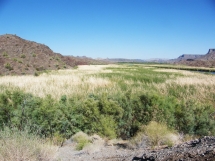The tamarisk beetle unexpectedly evolved to have the ability to establish below 37*N.
Initially, the Diorhabda beetles were unable to establish below this latitude because when the shorter days happened towards the end of summer, diapause would normally occur, inhibiting reproduction in preparation for the onset of winter and thus unsuitable conditions. However, a natural selection for a delayed response to shorter day periods promoted the establishment below the previously limiting latitude.
Some genetic forms of Diorhabda are more aptly suited for lower latitudes, and research is currently ongoing to determine the genetic forms present in North America.
The Chinese ecotype is more promising than the Kazakh ecotype, since the Chinese ecotype is found in sites from Wyoming to New Mexico, though it is not genetically distinguishable from the Kazakh ecotype at this time Because of this, current research is focused on discerning the appropriate expectation for adaptation and further establishment along the Lower Colorado River and the potential of the Colorado Delta in Mexico.
With this increase in potential habitat for the beetle, research is focusing on both the positive and negative implications. Negative impacts could include harming habitat for sensitive species, such as the SWFL, while on a positive note, the beetles could provide more resources for these species.
Determining the range of the tamarisk biocontrol in the Lower Colorado River Basin also involves sampling and monitoring of invertebrates in areas where Diorhabda establishment occurs. The monitoring will look at generalist predators that can slow the establishment of the tamarisk beetle as well as the potential food source that the beetles can become after establishment to both invertebrates and vertebrates alike.

 Bill Williams River along the Lower Gila River
Bill Williams River along the Lower Gila River